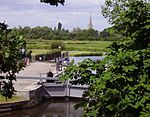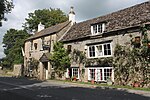St John the Baptist Church, Inglesham

St John the Baptist Church in Inglesham, near Swindon, Wiltshire, England, has Anglo-Saxon origins but most of the current structure was built around 1205. Much of the church has not changed since the medieval era. It is recorded in the National Heritage List for England as a Grade I listed building, and is now a redundant church which has been in the care of the Churches Conservation Trust since 1981. The church stands above the water meadows next to the confluence of the River Thames, River Coln and the Thames and Severn Canal. Much of the fabric of the building is from the 13th century, but includes remains of an earlier church on the site. The interior has wall paintings spanning over 600 years, often one on top of the other, up to seven layers thick. There is also a carving of the Mother and Child which dates from the Anglo-Saxon era. There are also historic box pews, pulpit and memorials.
Excerpt from the Wikipedia article St John the Baptist Church, Inglesham (License: CC BY-SA 3.0, Authors, Images).St John the Baptist Church, Inglesham
A361,
Geographical coordinates (GPS) Address Nearby Places Show on map
Geographical coordinates (GPS)
| Latitude | Longitude |
|---|---|
| N 51.68427 ° | E -1.70441 ° |
Address
A361
GL7 3AQ
England, United Kingdom
Open on Google Maps









